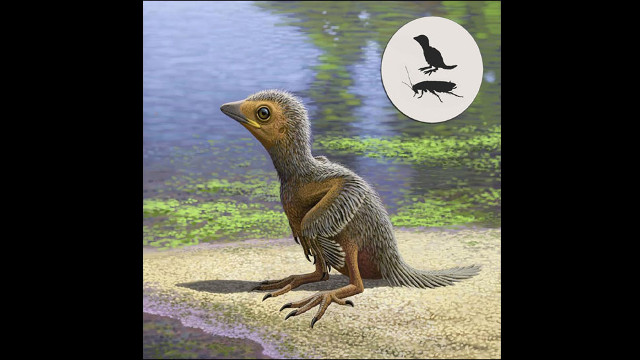Found fossils of prehistoric 127 million year old small birds
A scientist has discovered a small prehistoric fossil dating from the Mesozoic era (250-65 million years ago) that helped them learn more about the first small birds that appeared in the dinosaur era.
According to researchers at the University of Manchester in England, this fossil is a bird belonging to a group of prehistoric species called Enantiornithes.
Measuring less than 5 cm in size - smaller than the tiny finger on an adult's hand, this may be one of the smallest Mesozoic fossils ever discovered. It consists of a nearly complete skeleton and weighs only three ounces when it is alive in the past.
 Found fossils of prehistoric 127 million year old small birds Picture 1
Found fossils of prehistoric 127 million year old small birds Picture 1
What makes this fossil important and unique? The researchers say this is an important stage in bird bone formation. That means the extremely short life of this small bird in the past has given researchers a rare opportunity to analyze the bone structure and development of this bird.
Fabien Knoll of the University of Manchester said: "The diversification of bird evolution can lead to important studies in hatching behavior as well as differences in growth rates among birds. By analyzing bone growth, we can look at a variety of evolutionary characteristics. "
With this small bird fossil, the team used synchrotron radiation to capture images of small specimens, observing the structure of the bone in the best detail. The researchers found that the baby's sternum is still made from cartilage and has not yet grown from a strong skeleton, which is quite hard, less flexible, so it may not fly in the past.
"The new discovery allows us to take a closer look at the world of ancient birds that lived in the dinosaur age," said Luis Chiappe from Los Angeles Natural History Museum in the US. "It's amazing how many traits and behaviors we can see in birds growing over 100 million years ago."
You should read it
- A new breed of turkey dinosaurs found in Australia
- Dinosaurs evolved into birds from millions of years ago
- Giant bat fossils have been discovered
- Fossils of Thailand's largest dinosaur have just been found
- The remains of dinosaur suspects were discovered in Uttarakhand, India
- Secrets about the world's smallest dinosaur revealed in amber 99 million years old
- India first discovered fossils of fish lizards
- The 110 million-year-old dinosaur fossil intact as alive
- Dinosaurs have used colors to camouflage
- Birds have poison, can kill people just by touching the feathers
- In terms of size, where does the human being stand for a dinosaur?
- 'Falling' with the reason why birds don't have teeth
May be interested

Footprints of 13,000-year-old people are found off Canada's Pacific coast

Found 2,000 year old wine from the ancient tomb of the Qin Dynasty

5.6 tons of coins were excavated under the house in Jiangxi, China

Stock of ancient silver coins found near Mezdra of Bulgaria

The 30,000-year-old face was amazingly reproduced

The statue of Ankhnespepy II queen was unearthed in Sakkara






 Found strange ancient parrot fossils 18 million years old
Found strange ancient parrot fossils 18 million years old A new breed of turkey dinosaurs found in Australia
A new breed of turkey dinosaurs found in Australia Giant bat fossils have been discovered
Giant bat fossils have been discovered The 32 million-year-old fossil tree is found in China
The 32 million-year-old fossil tree is found in China The mystery of the 290-million-year-old giants challenges scientists around the world
The mystery of the 290-million-year-old giants challenges scientists around the world The second time the ancient fossil '3 in 1' was discovered
The second time the ancient fossil '3 in 1' was discovered